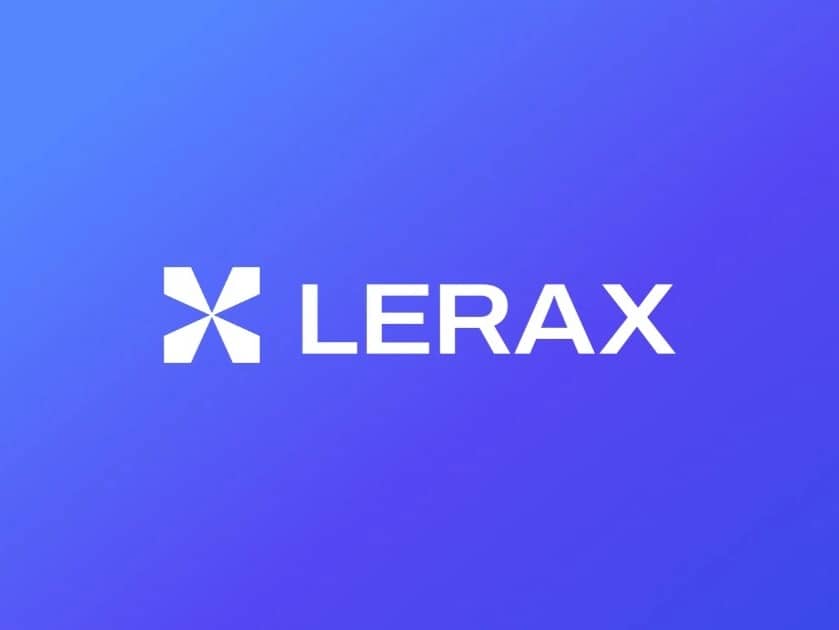订阅 wiki
Share wiki
Bookmark
LERAX
LERAX
LERAX is a blockchain platform designed to facilitate the tokenization of Real-World Assets (RWAs). The project aims to bridge traditional financial assets with the decentralized finance (DeFi) ecosystem by representing physical and financial assets as digital tokens on its network. [2]
Overview
LERAX Chain is a Layer 1 Proof-of-Authority blockchain specifically designed to integrate the $400 trillion real-world asset economy with decentralized finance. It enables compliant tokenization of physical assets—including real estate, commodities, bonds, and intellectual property—through a network of KYC-verified institutions that ensure regulatory finality. The platform supports gasless enterprise transactions with service-level agreements for high-volume settlements, legally enforceable smart contracts, and fractional ownership down to micro-shares with automatic dividend distribution. Additionally, LERAX Chain incorporates GDPR-compliant privacy features via hybrid subnets and real-world oracle feeds for asset valuation, title verification, and transparent on-chain settlement. [1]
Features
Proof-of-Authority Consensus
LERAX Chain is a Layer 1 blockchain, purpose-built for the tokenization of real-world assets, and engineered to strike a balance between scalability, security, and regulatory compliance. Its modular architecture enables the flexible deployment of enterprise-grade features, allowing for transparent and auditable management of assets, including real estate, commodities, bonds, and intellectual property. The platform is designed to support high-volume settlements, fractional ownership, and legally enforceable smart contracts, providing a comprehensive infrastructure for institutional and government adoption.
The chain uses a Proof-of-Authority (PoA) consensus mechanism, in which a set of pre-approved, KYC-verified validators are authorized to validate transactions and produce blocks. This approach delivers instant finality, confirming transactions within seconds, while consuming minimal energy compared with Proof-of-Work systems. PoA also enhances security, as validators are known and vetted entities, reducing potential attack surfaces and ensuring regulatory alignment for jurisdictions that require identifiable participants. By combining these elements, LERAX Chain creates a reliable, efficient, and compliant environment for bringing real-world assets onto the blockchain. [3]
RWA Tokenization
LERAX provides infrastructure for institutions to tokenize, manage, and exchange real-world assets with regulatory transparency and on-chain auditability. The platform supports banks, asset managers, private equity firms, academic institutions, and tokenized asset exchanges, offering tools for compliant token issuance, KYC/AML, asset auditing, and secure multi-signature wallets.
Key features include an on-chain registry for proof of ownership, smart contract templates for tokenization, revenue sharing, and debt issuance, as well as a proof-of-reserve framework for auditor-verified asset backing. LERAX also facilitates fractional asset trading, regulated secondary market listings, real-time price discovery, and liquidity provision, with planned integration across Singapore, Europe, and the U.S. Academic and research partnerships further support risk modeling, legal frameworks, hybrid DeFi-RWA products, and governance simulations. [4]
LERAX Nodes
A LERAX Node is a specialized participant in the LERAX ecosystem operating under the Proof-of-Authority consensus model, where a select set of trusted authorities validate transactions rather than competing for block production. Node holders support fast, secure, and low-cost blockchain operation while participating in governance, reward distribution, and real-world asset innovation.
LERAX Nodes function as governance anchors for the ecosystem, granting holders voting power on community proposals, protocol upgrades, and fund allocations. They also provide early access to new partnerships, tokenized asset listings, and RWA investments, while linking directly to token emission mechanisms for tier-based rewards. Additional privileges include eligibility for ambassador programs and the ability to influence LERAX’s roadmap and asset selection. [5]
Governance
LERAX Chain is governed by a decentralized autonomous organization (DAO) that enables community-led decision-making and long-term network sustainability. Node operators and core contributors participate in on-chain governance, with all proposals, votes, results, fund transfers, and milestones fully auditable through the LERAX Explorer. [6]
Tokenomics
LERAX has a fixed total supply of 100 billion tokens, structured to support ecosystem growth, core infrastructure, and contributor rewards. All token movements are fully transparent and traceable on the LERAX Blockchain Explorer, with labeled wallets for categories such as staking, liquidity, and the ecosystem fund. This allows users to verify allocations, usage, and unlock schedules. The distribution is as follows: [7]
- Team: 1%
- Node Rewards: 30%
- RWA Reserve: 20%
- Staking Rewards: 10%
- Liquidity pool: 15%
- Ecosystem Fund: 14%
- CEX Listings: 5%
- Airdrop: 5%
Partnerships
- Spiko
- EMAAR
- Circle
- Apollo
- Centrifuge
- Fidelity
- Hamilton Lane
- Libre
- Arichain
- IQ.wiki
- Web3 Decision
发现错误了吗?
